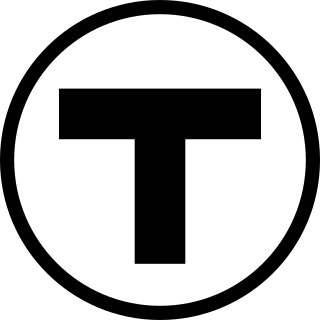
The Massachusetts Bay Transportation Authority is the public agency responsible for operating most public transportation services in Greater Boston, Massachusetts. Earlier modes of public transportation in Boston were independently owned and operated; many were first folded into a single agency with the formation of the Metropolitan Transit Authority (MTA) in 1947. The MTA was replaced in 1964 with the present-day MBTA, which was established as an individual department within the Commonwealth of Massachusetts before becoming a division of the Massachusetts Department of Transportation (MassDOT) in 2009.

The Orange Line is one of the four subway lines of the Massachusetts Bay Transportation Authority. It extends from Forest Hills in Jamaica Plain, Boston in the south to Oak Grove in Malden in the north. It meets the Red Line at Downtown Crossing, the Blue Line at State, and the Green Line at Haymarket and North Station. It connects with Amtrak service at Back Bay and North Station, and with MBTA Commuter Rail service at Back Bay, North Station, Forest Hills, Ruggles station in Roxbury, and Malden Center in Malden. From 1901 to 1987, it provided the first elevated rapid transit in Boston; the last elevated section was torn down in 1987 when the southern portion of the line was moved to the Southwest Corridor.

North Station is a major transportation hub located at Causeway and Nashua Streets in Boston, Massachusetts, United States. It is one of the city's two inbound terminals for Amtrak and MBTA Commuter Rail trains, the other being South Station. The main concourse of North Station is located at the street level immediately below TD Garden, a major sports arena. The arena is also used for concerts and other events, taking advantage of the extensive transportation connections at the site.

Downtown Crossing, colloquially known as DTX, is a rapid transit station located in Boston, Massachusetts. It is located in the Downtown Crossing retail district in downtown Boston. It is the junction of the Massachusetts Bay Transportation Authority (MBTA)'s Orange and Red Lines, and is one of four "hub stations" on the MBTA Subway system, as well as a major bus transfer location serving 13 MBTA Bus routes, including one Silver Line route.

Longwood Medical Area is a light rail stop on the MBTA Green Line "E" Branch, located in the Mission Hill neighborhood of Boston, Massachusetts. It is the named for the adjacent Longwood Medical Area, which is the home of Harvard Medical School, Children's Hospital Boston, and Brigham and Women's Hospital.

The MBTA Commuter Rail system serves as the commuter rail arm of the Massachusetts Bay Transportation Authority's transportation coverage of Greater Boston in the United States. Trains run over 398 miles of track to 137 different stations, with 58 stations on the north side with the remaining 79 stations on the south. It is operated under contract by Keolis, which took over operations on July 1, 2014 from the Massachusetts Bay Commuter Railroad Company (MBCR).
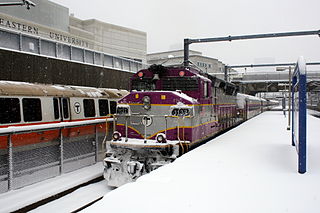
Ruggles is an intermodal transfer station in Boston, Massachusetts. It serves MBTA rapid transit, bus, and commuter rail services and is located at the intersection of Ruggles and Tremont streets, where the Roxbury, Fenway-Kenmore and Mission Hill neighborhoods meet. The station occupies the site that was previously the South End Grounds, home of the former Boston Braves from 1871 to 1914. It is surrounded by the campus of Northeastern University.

Hynes Convention Center is an underground light rail station on the MBTA Green Line, located at the intersection of Newbury Street and Massachusetts Avenue at the Hynes Convention Center, located in the western end of the Back Bay neighborhood of Boston, Massachusetts. It was opened by the Boston Elevated Railway (BERy) in 1914 as a transfer station between east-west streetcars running in the Boylston Street Subway to the Tremont Street Subway, and north-south streetcars on Massachusetts Avenue. The surface cars were replaced by buses in the mid-20th century; Hynes is still a transfer location to the key route 1 bus and two other MBTA bus routes.

The Framingham/Worcester Line of the MBTA Commuter Rail system runs west from Boston, Massachusetts to Worcester, Massachusetts through the MetroWest region, serving 17 station stops in Boston, Newton, Wellesley, Natick, Framingham, Ashland, Southborough, Westborough, Grafton, and Worcester. The third-longest and second-busiest line on the system, the Framingham/Worcester Line is plagued by poor track conditions, interference from freight trains, and a number of non-handicapped-accessible stations. Service on the line is a mix of local and express trains serving Worcester plus short-turn Framingham locals.
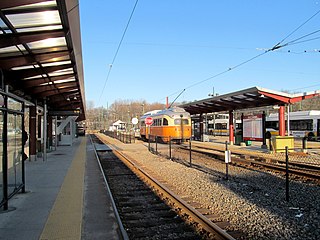
Mattapan is an MBTA transit station in Boston, Massachusetts. It is the southern terminus of the Ashmont–Mattapan High Speed Line, part of the Red Line, and is also an important MBTA Bus transfer station, with ten routes terminating there. It is located at Mattapan Square in the Mattapan neighborhood. At the station, trolleys use a balloon loop to reverse direction back to Ashmont station. Mattapan station is fully accessible, with mini-high platforms for boarding trolleys.
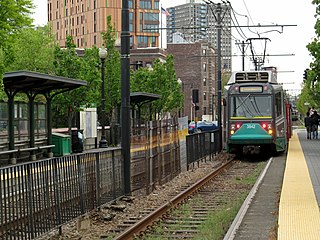
Museum of Fine Arts is a surface-level light rail stop on the MBTA Green Line "E" Branch, located the median of Huntington Avenue in Boston, Massachusetts, between Museum Road and Ruggles Street. The station is named after the adjacent Museum of Fine Arts, although it also provides access to Northeastern University, Wentworth Institute of Technology, and the Isabella Stewart Gardner Museum. Museum of Fine Arts station is accessible.

Copley is an underground light rail station on the MBTA Green Line, located in the Back Bay section of Boston, Massachusetts. Located in and named after Copley Square, the station has entrances and exits along Boylston Street and Dartmouth Street.

Massachusetts Avenue is a rapid transit station in Boston, Massachusetts. It serves the MBTA Orange Line, and is located at 380 Massachusetts Avenue. The station opened in 1987 as part of the renovation and relocation of the southern Orange Line into the Southwest Corridor. The Orange line runs parallel to the Northeast Corridor, which carries Amtrak trains and several MBTA commuter rail lines.

The Providence/Stoughton Line is a line of the MBTA Commuter Rail system running southwest from Boston, Massachusetts, USA. The main line was originally built by the Boston and Providence Railroad, and now carries commuter trains between South Station in Boston and Wickford Junction station in North Kingstown, Rhode Island. The Stoughton Branch, built as the Stoughton Branch Railroad, splits at Canton Junction and runs for two more stations to Stoughton station in Stoughton, Massachusetts.
The Boston Subdivision is a railroad line owned by CSX Transportation in the U.S. state of Massachusetts. The line runs from Worcester west to near Springfield along a former New York Central Railroad line. Its east end is at Amtrak's Northeast Corridor at Back Bay Station, over which CSX has trackage rights to the east to reach the Dorchester Branch. Its west end is in Wilbraham, east of Springfield, at the east end of the Berkshire Subdivision. Along the way, the line junctions with the Framingham Subdivision and Fitchburg Subdivision at Framingham.
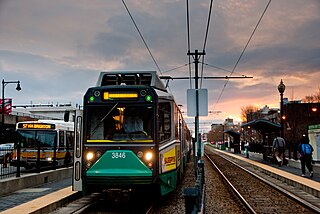
Boston University Central is a surface-level light rail station on the MBTA Green Line "B" Branch, located the center median of Commonwealth Avenue west of St. Marys Street in Boston, Massachusetts, surrounded by the Boston University campus. It consists of two side platforms, which serve the "B" Branch's two tracks.
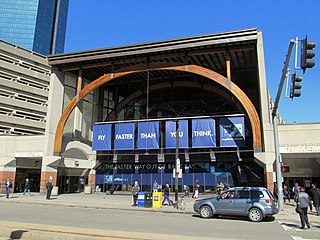
Back Bay Station is an intermodal passenger station in Boston, Massachusetts. It is located just south of Copley Square in Boston's Back Bay and South End neighborhoods, it serves MBTA Commuter Rail and MBTA subway routes, and also serves as a secondary Amtrak intercity rail station for Boston. The present building, designed by Kallmann McKinnell & Wood, opened in 1987. It replaced the New Haven Railroad's older Back Bay station - which opened in 1928 as a replacement for an 1899-built station - as well as the New York Central's Huntington Avenue and Trinity Place stations which had been demolished in 1964.

The 1990 Back Bay, Massachusetts train collision was a collision between an Amtrak passenger train, the Night Owl, and a Massachusetts Bay Transportation Authority (MBTA) Stoughton Line commuter train just outside Back Bay station in Boston, Massachusetts. An investigation by the National Transportation Safety Board (NTSB) found that the Amtrak train entered a speed-restricted curve at excessive speed, causing the train to derail and crash into the MBTA commuter train on an adjoining track. Although no one was killed in the accident, 453 people were injured and Back Bay station was closed for six days. Total damage was estimated at $14 million. The accident led to new speed restrictions and safety improvements in the vicinity of Back Bay and a revamp of Amtrak's locomotive engineer training program.
The Massachusetts Bay Transportation Authority operates subway, bus, commuter rail, and ferry service in the Greater Boston region. Boston has some of the highest rates of non-motorized commuting in the United States, including high bicycle usage. The MBTA offers certain provisions for riders wishing to make part of their trips by bicycle. The agency allows bicycles to be carried on all fixed-route services except the Green Line and the Ashmont-Mattapan High Speed Line light rail lines, although they are restricted on the commuter rail and heavy rail subway services at peak hours. Bicycle storage areas are offered at many stations, with "Pedal and Park" locking bicycle cages at certain high-usage stations.


















